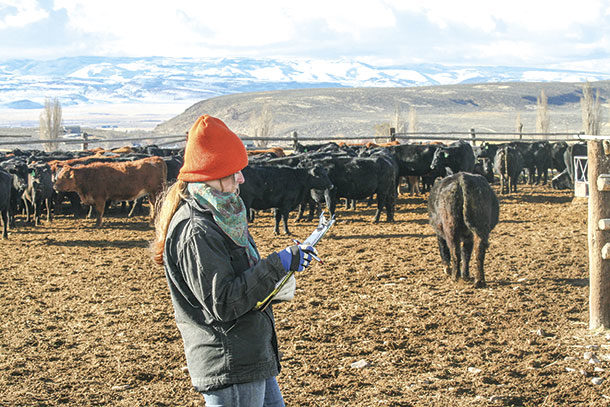But do you need or use all that information?
To be useful, production records need to answer questions about your production goals. All producers have that favorite production record they like to track. But does that record tell you if you are reaching a production goal, or are you even using that information to make management decisions? The records kept need to be determined by the goals of your operation.
Setting goals
There is lots of information and guidelines of how to set goals, but the most important thing is to set goals. Make them official by writing them down and sharing them with your crew. Goals need to be SMART goals.
- S – Specific: Well-defined; clear to anyone that has a basic knowledge of the operation
- M – Measurable: If you can’t measure it, there is no way to determine if you have achieved it
- A – Attainable and agreed upon: Agreement with all stakeholders what the goals should be
- R – Realistic: Within the availability of resources, knowledge and time
- T – Tangible and time-based: Enough time to achieve the goal, and progress can be tracked
You also need to assign a cost to each goal for direction, focus and standard of measurement. In most cases, there will be a cost to achieve the goals. The dollar amount determined to reach a goal should be included in your operation’s budget. A written goal needs action, results, time and cost. Action is the verb of your goal, what you want to have happen. The result is the finished project. Time gives a window of opportunity for it to happen. Costs represent expenditures necessary to reach the goal.
After you have written goals, determine what records you need to keep and analyze to determine if progress is being made toward achieving the goal. Let’s examine some sample goals and the records necessary to determine success.
Records
Goal: Reduce calf death loss by 3% by 2022. Cost $1,000
As we examine this goal, we need to review past records to see if 3% reduction is realistic. How many calves died and at what age? Determining the causes of death will help determine the cost to reach the goal. If the cause of death was weather-related, then cost incurred may be more bedding material, an additional shed or windbreak. If the cause was “big calves,” the cost may be dollars spent on calving-ease bulls or change in feed so heifers are larger. The additional cost may be to send the crew to calving school so they develop the necessary skills to assist the cow or heifer.
Some records to keep as you move forward would include:
- Cow identification
- Age of calf at death
- Environmental conditions
- Health of calf before it died
- Reason for calf dying
Once you have these recorded, then you can begin to analyze the information. As you look at the cow, did her calf die the previous year? If so, was it the same cause? If all the calves died at the same age, was it something spread from calf to calf such as scours? We do not have control over environmental conditions, but did many calves die due to cold temperatures? Was the calf fine one day and dead the next? If this is the case, a necropsy may be in order. If you know why the calf died, record to help determine what management changes need to happen. For operations running on public lands, you may not be able to answer any of these questions. All you know is that the cow came home without a calf.
Goal: Increase the number of calves born in the first 30 days of the calving season 4% by 2023. Costs $2,500
Recording the date each calf is born is step 1 in achieving this goal. Once those dates are recorded, then calculate how many calves are born in the first 30 days and how many in the next 30 days. You may want to take a look and see if each cow is calving on a regular basis or if she is getting later each year. Look at each cow individually and the herd. If a few cows are getting later each year, are they older cows past their prime or younger cows that are still growing?
To analyze this, you will need to record the age of cows in the herd. With that information, you can make some management decisions. The cost to reach this goal could be in the form of purchasing an additional bull, feed analysis and more feed to meet the nutritional demands of the cow or additional feed to hold cattle at home longer before they move onto public lands.
Body condition may be a record you want to keep. You may consider doing body condition scoring as the cows go into calving season, then at calving and 30 days post-calving. While this may seem like a lot of records, it would give you a good indication of the nutritional value of your feed. Within 30 to 60 days, you are asking a cow to calve, keep a calf alive, produce milk, repair her uterus and get pregnant. This takes good nutrition and serious management.
You may need to look at your bull records. How many bulls are you turning out? How has each bull done on their spring breeding soundness exam? What does their semen count look like? As you look at these records, you may determine the need to purchase some new bulls or additional bulls. If you are running on public lands, look at your turn-out date as compared to your turn-in date for the bulls. Are you asking the bulls to cover a lot of country?
Profitability is what every operation wants to achieve. Each cow needs to produce a product. To know the level of productivity, you should consider keeping records of:
- Percent of cow herd weaning calves or which cows wean a calf
- Amount of weight weaned (total herd) or weaning weight of individual calves
You can keep these records on a herd basis or individual cow basis. If you keep it on a herd basis, you will know the herd total from year to year and will have to use other records to determine who stays and who is culled. If you keep it on an individual basis, you will know exactly what each cow is producing.
Records do not have to be kept electronically. There is nothing wrong with a calendar, notebook, “red book,” notes on your phone or computer. Use the system that works for you and your operation. If the record system is so complex it gives you a headache, you are not going to apply it. Pick a system you will use and use on a regular basis.
Management
You have goals and records. Now it’s time for management decisions. I saw a quote the other day, “Stay focused on your goal but flexible enough to take another route to get to it when necessary.” Management is making decisions and utilizing your resources. Just as you should share your operation’s goals, share the management plan to reach those goals. Spend time reviewing all the data with the team and discussing management options before making decisions.
The key to the correct records is to start. Know the goals of your operation. Determine what information needs to be kept and start recording. It really is simple to have information that tells you something you need to know.








